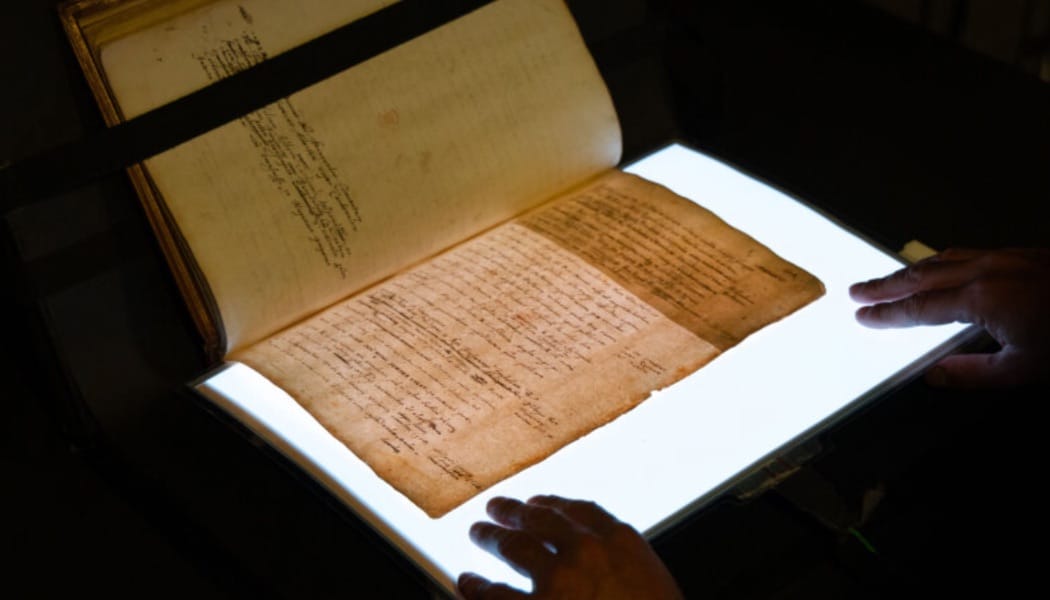Image: Camden Annals (British Library)
Imaging technique reveals alternative version of Elizabeth I deathbed scene, questioning Camden’s reliability as James I’s commissioned historian.
Digitisation is a tool for preserving historical documents and making them accessible for future generations. At the British Library, however, the Digitisation Services team have also been using digitisation as a means of discovery. Using simple techniques, they have been able to reveal previously obscured words from a 17th century text, The Camden Annals, shining new light on this important historical document for researchers and historians.
What are the Camden Annals?
Annals are historical records in which events are arranged chronologically. William Camden’s Annals is a handwritten account in Latin, created by the British historian William Camden (1551–1623). It documents events during the reign of Elizabeth I, and was commissioned by her successor, King James I. The Annals have widely been regarded as a reliable historical document, as many of Camden’s entries are based on eyewitness reports and parliamentary records.
However, Camden heavily edited his own content, rendering vast swathes of the Annals indecipherable. Words and paragraphs throughout the Annals are written over, covered in paper or obscured. Some entire pages are even stuck together, so conservators cannot prise them apart without causing damage. Historians theorise that Camden did this to cover up any writing that could offend his patron, leaving his original accounts unreadable to scholars for over 400 years.
Digitisation to the rescue
This is where the British Library’s Digitisation Services stepped in. Using an imaging technique known as Transmitted light, the team were able to read texts obscured by paper or between glued folios. This technique works by backlighting the folios with a light sheet. Both sides of each folio were captured using this technique, and the images edited or sometimes combined to enhance the visibility of concealed text.
What did we uncover?
The team uncovered passages that had been crossed out or hidden within the pages of the Annals, revealing fresh details about Elizabeth I’s reign, as well as Camden’s motivations as a writer.
One entry in the Annals (the so-called ‘deathbed scene’) documents James I being personally nominated by Elizabeth as her successor, while she lay dying in bed. The Digitisation Services team were able to uncover an alternative version of this account hidden underneath a stuck-on piece of paper. In this version of events, the ‘deathbed scene’ is entirely absent. Indeed, historical scholarship stipulates that Elizabeth was too sick to appoint anyone by name before she died. Historians have suggested that Camden rewrote this fabricated story into the Annals to please James by corroborating his claim to the throne.
Discoveries like this raise exciting questions for historians regarding our perception of Elizabethan history and the reliability of Camden as a narrator. Did he alter his accounts to curry favour with James I? Was he forced to change his version of events to avoid persecution?
Julian Harrison, Lead Curator of Medieval Historical and Literary Manuscripts, commented: ‘The results of the specialist imaging are phenomenal, they have revolutionised our understanding of this important period of British history.’
The analysis of the Annals of Elizabeth I was undertaken by Helena Rutkowska, a PhD student at the British Library, with the imaging being funded by the British Library Collections Trust.
What next?
As technology advances, other new tools like artificial intelligence and machine learning may further help decode historical texts, deepening our understanding of the past.
The British Library is an industry leader in digitising and preserving historical documents. From simple digitisation techniques to 3D scanning and animation, their work ensures that fragile manuscripts are preserved for future generations.
As this article highlights, digitisation’s capabilities don’t end there. We are now able to use technology to uncover important new information about the past. What other hidden secrets are out there that digitisation could unearth?
If you have a collection or historical item that might have uncovered secrets, do not hesitate to reach out to the Library’s team at [email protected], and they’ll be happy to see what they can do (or find!) for you
Sources
Showing Elizabeth I in a new light – Medieval manuscripts blog
Hidden for 400 Years, Censored Pages Reveal New Insights Into Elizabeth I’s Reign





